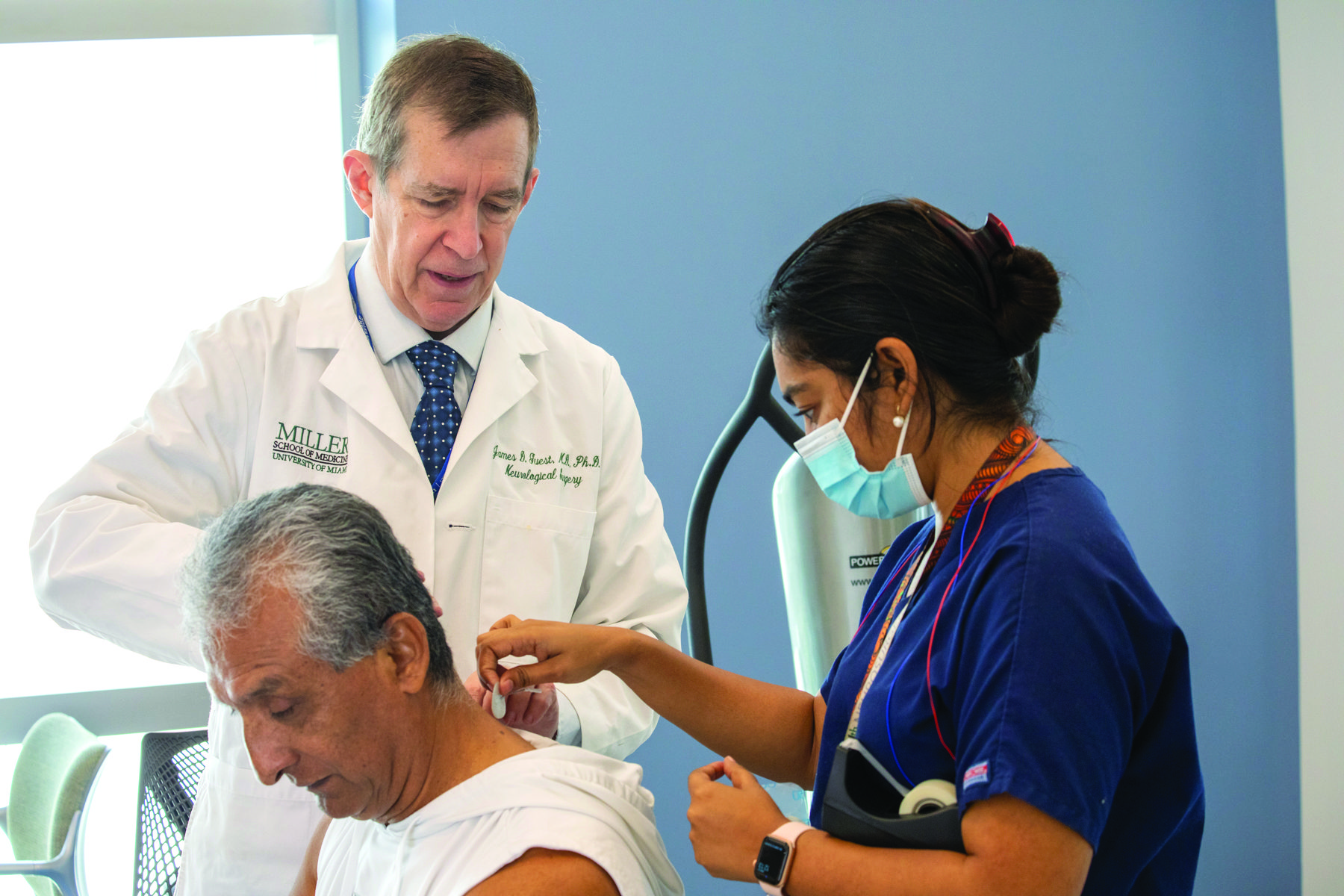(November, 2024) In a large multicenter clinical trial recently published in Nature Medicine that evaluated the safety and efficacy of ARC Therapy to improve arm and hand functions in people with chronic spinal cord injury, University of Miami Miller School of Medicine and other researchers found 72% of those studied experienced meaningful improvements in strength and function.
ARC Therapy delivers externally applied electrical stimulation over the cervical spinal cord during structured rehabilitation.
A Milestone of Success in SCI
“This is one of the first, if not the first, pivotal trial to be conducted in spinal cord injury that was successful in most of the participants,” said the study’s Miller School principal investigator James D. Guest, M.D., Ph.D., professor of neurological surgery at the Miller School. “In this study of 65 spinal cord patients, we met the clinical endpoint that this therapy, transcutaneous cervical stimulation, can move forward for FDA approval of a device. If it’s approved, it can begin to be implemented in clinics in North America and hopefully across the world.”
The finding that nearly three-quarters of those studied responded to stimulation treatment and achieved gains in the function of their arms and hands means better quality of life, according to Dr. Guest.
“When you’re dealing with people who have tetraplegia and quadriplegia, they often are dependent upon others for really simple things, like feeding themselves, pushing a button for an elevator, or being able to enter a number on a cell phone. The gains that people in the study experienced were relevant to those kinds of daily tasks,” Dr. Guest said.
A Worldwide Collaboration
The Miller School and The Miami Project to Cure Paralysis were part of an elite worldwide collaboration for the trial (called the Up-LIFT), including former member of The Miami Project Edelle C. Filed Fote, P.T., Ph.D., who directs spinal cord injury research at the Shepherd Center in Atlanta and is a professor at Emory University and George Institute of Technology. Leslie R. Morse, D.O., professor and chair of physical medicine and rehabilitation at the Miller School, was also among the authors. Dr. Morse was at the University of Minnesota School of Medicine at the time of the trial and served as that site’s principal investigator.
“Congratulations to all the dedicated faculty, staff, and trainees that helped make this important trial successful. A special thanks to our Miami Project clinical research team in the Christine E. Lynn Rehabilitation Center, who contributed to the completion of this seminal study and the impressive findings,” said W. Dalton Dietrich, Ph.D., scientific director of The Miami Project to Cure Paralysis and professor of neurological surgery.
Important Step Up from Rehab Only
Researchers compared ARC Therapy to a preceding equivalent period of rehabilitation, alone. They found that while participants in the Up-LIFT trial demonstrated some improvement in measures of arm and hand functions after a period of rehabilitation alone, their neurological status improved more significantly when delivering ARC Therapy.
“Persons with lived spinal cord injury experience have made an urgent call to the scientific community to accelerate discoveries that improve function, particularly of the hands and arms, in chronic spinal cord injury. This study is an important step in that direction, and I am honored to have been part of this team,” Dr. Morse said.
Participants also reported a decrease in the frequency and severity of muscle spasms, improved sleep quality and reduced pain–improvements that translated into notable increases in overall well-being.
The therapy, according to Dr. Guest, is not noninvasive in that it does not require any type of implant.
“You can put electrodes on and have this for an hour, three times a week, and the rest of the time you don’t have to deal with any devices being attached to your body,” he said. “ARC Therapy is quite simple. One can be trained quite quickly to do it, so it’s one of those things that centers that specialize in spinal cord injury can scale up, which is an issue that we have in the spinal cord injury field. Many of the most impressive things that we can do are not scalable.”
What’s Next?
Dr. Guest and colleagues will soon launch an investigator-initiated study using these stimulators, which Onward Medical has provided. The researchers will look beyond the findings of the Nature Medicine study, at such things as the therapy’s effects on spasticity. They’ll also study the optimal duration of the treatment.
“People were in the study for four months. They only received stimulation for two months. And many people were still improving at the end and were sad the study was over,” Dr. Guest said. “We’re going to be studying a longer time frame to try and figure out when people stop showing a recovery benefit.”
By Lisette Hilton

